Parquet Floor Fitting Guide
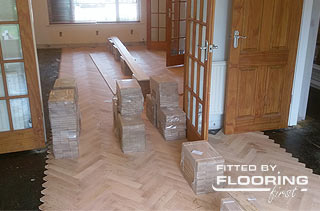 Parquet flooring is a classic - it brings style and luxury to any interior. It allows various fitting designs and it can also accommodate additional elements such as figures, borders and edging of a different type of wood.
Parquet flooring is a classic - it brings style and luxury to any interior. It allows various fitting designs and it can also accommodate additional elements such as figures, borders and edging of a different type of wood.
Parquet floor fitting is not as easy as some other types of wood floors. Please, keep in mind that the purpose of this article is to provide general tips and advice when laying parquetry, not a complete in-depth guide because we believe this is a job best left to professionals.
Wooden floors of any kind should be installed only, after all, the “wet” work – concrete, drywall, masonry, and painting are completely dry and finished. Anything that could possibly cause increased moisture levels must be taken care of before even considering parquet floor installation - for example, if you have a plumbing problem you better fix it now.
Parquet Acclimatisation
There is one factor determining whether or not a parquet floor will suit a certain room and that factor is the amount of moisture in the installation site. Two weeks before the installation, humidity in the area must be around 40-60% and the temperature no less than 65-75° F.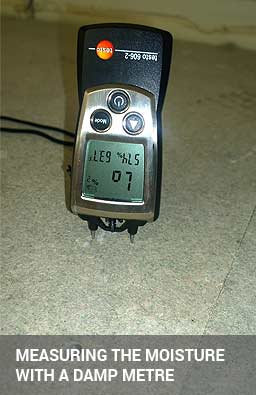 Wood is a hygroscopic material. It will expand in damp conditions and shrink when dry. Seasonal floor movement is something natural and cannot be prevented. The term “wood tolerance” is used to describe the variations in the size and thickness of the wood that can occur, mostly due to changes in temperature and humidity. The normal tolerance is a maximum of 3 mm across a metre.
Wood is a hygroscopic material. It will expand in damp conditions and shrink when dry. Seasonal floor movement is something natural and cannot be prevented. The term “wood tolerance” is used to describe the variations in the size and thickness of the wood that can occur, mostly due to changes in temperature and humidity. The normal tolerance is a maximum of 3 mm across a metre.
To ensure that the parquet blocks are less prone to moving and warping, acclimatisation must be performed. Two weeks prior to the instalment the parquet blocks should be left in the room where they are about to be laid and given time to adjust. They are to be put in small piles and exposed as much as possible to the air in the room.
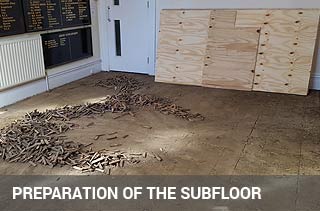
Subfloor Preparation
The subfloor preparation is the most important part of the installation. The perfect subfloor should be:
Dry. Subfloor humidity must not be above 12%.
Flat. Within 3/16" in 10' and/or 1/8" in 6'.
Structurally healthy. Stable, solid subfloor without water damage or squeaky areas.
Clean. That means free of debris as well as any old adhesives.
Parquet Installation
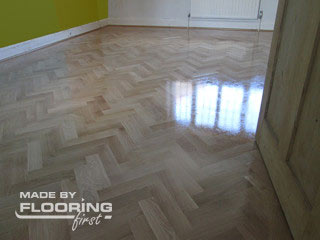 Parquets allow a lot of freedom when it comes to their installation since they can be laid upon almost everything - from concrete and self-levelling compounds to dry screed and plywood.
Parquets allow a lot of freedom when it comes to their installation since they can be laid upon almost everything - from concrete and self-levelling compounds to dry screed and plywood.
If the parquet is reclaimed and there are traces of bitumen they must be scraped. Bitumen can cause lumps if not removed while not contributing anything to the stability of the newly laid floor. Some adhesives can work with him but the more removed the better. The tongues and grooves must be cleaned as well.
How to Lay Parquet Flooring?
There are several popular parquet patterns – brick bond, diagonal basket and the most popular of all – herringbone. For the installation itself, the parquet pattern doesn’t matter much. Usually, we begin by establishing a central line in the middle of the room where we begin to lay the parquet blocks across its length. From this line, we carefully expand the pattern until we reach the edges of the area where we leave a gap of around 12-15 mm. We do this to give the parquet some place to expand if needed. The gap will then be covered by skirting or so it won’t be visible.
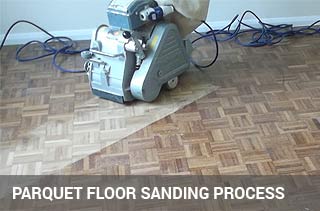
Floor Sanding and Sealing
The main rule when sanding a wooden floor is to follow the grain. When you have a pattern where the grain of the different blocks does not follow the same direction (herringbone) it’s best to sand diagonally in the direction of each. This way all blocks are stripped equally.
Staining is not advised when the parquet is made out of multiple wood species because the different wood types will react according to their own unique characteristics. At the moment, the most popular and durable choice for floor finish is water-based lacquers. There is no reason not to use them here unless you are seeking a more specific look.
Maintenance and Aftercare
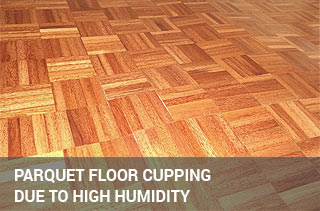 Usually, most of our floor installations come with a warranty of 2 years. There are areas, however, where the moisture levels are simply too high to fit a wooden floor yet the client insists he wants the installation to be performed there. We can fulfil the wish of the customer but we just cannot provide the same warranty. Before we proceed with the laying we always warn them of the potential risks and dangers involved.
Usually, most of our floor installations come with a warranty of 2 years. There are areas, however, where the moisture levels are simply too high to fit a wooden floor yet the client insists he wants the installation to be performed there. We can fulfil the wish of the customer but we just cannot provide the same warranty. Before we proceed with the laying we always warn them of the potential risks and dangers involved.
If those warnings are ignored there is little that can be done to prevent the floor from getting damaged if the humidity levels rise above the acceptable 40-60%. Some flooring companies offer to provide dehumidifying services with the same equipment used to prepare the place for the instalment but it is at best a patch-up job so we do not offer it. If it appears once it will probably do so again and again… The best way to prevent unnecessary movement, gaps and possible warping is to keep the temperature in the room consistent.
Lacquers provide the best surface protection but if you decide to go for oils you have to be a bit more careful. Over time, oiled floors can change colour and become yellowish. To avoid that effect for as long as possible, the parquet should not be exposed to direct sunlight for extended periods of time. This can be done by placing a lot of rugs and carpets.
Spills can also harm oiled floors if left unattended. A damp cloth should be used to remove such spills as soon as possible. The big benefit of oils is that you can re-oil pretty often and cover some minor damage. However, stains caused by spilling may require a spot remover to deal with them.